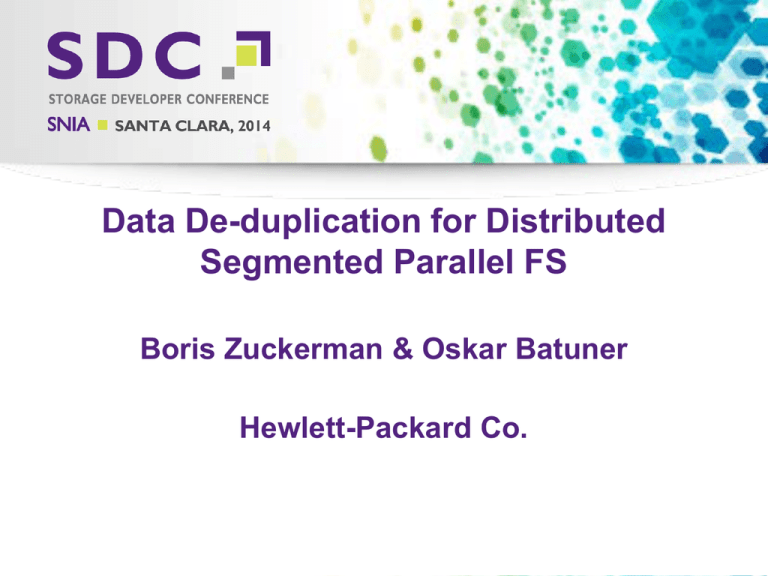
Data De-duplication for Distributed
Segmented Parallel FS
Boris Zuckerman & Oskar Batuner
Hewlett-Packard Co.
2014 Storage Developer Conference. © Hewlett-Packard. All Rights Reserved.
Objectives
Expose fundamentals of highly distributed
segmented parallel file system architecture
Review the challenges and goals of
implementing de-duplication
Show key points of the design:
Role of ES in de-duplication
Segmented Indexing and Index Segment Servers
Data Chunk Files, Manifests, Index Files
Representative Keys, Key Groups
Questions
2
2014 Storage Developer Conference. © Hewlett-Packard. All Rights Reserved.
How to scale high?
3
2014 Storage Developer Conference. © Hewlett-Packard. All Rights Reserved.
Scalable segmented FS architecture
Splits physical and logical space
into segments
Assigns control over storage
segments to segment servers
Segment servers are entirely
responsible for file (inode) and
block allocation within the
boundaries of the individual
segments
segment servers coordinate
caches and activities associated
with objects they maintain
Files and directories are
distributed through the sets of
segments
4
2014 Storage Developer Conference. © Hewlett-Packard. All Rights Reserved.
De-duplication Design: Goals
Efficiency - design and implementation should be
efficient enough to avoid degrading throughput of
sequential write and read operations
Scalability – the proposed design should be as scalable
as the overall file system. In other words, adding more
servers and segments to the de-duplication space
should allow it to handle proportionally larger cumulative
load
Manageability – set of tools and utilities should be
provided to de-duplicate, restore, copy, compare,
replicate de-duplicated data, etc.
5
2014 Storage Developer Conference. © Hewlett-Packard. All Rights Reserved.
De-duplication Design Goals: Efficiency
Avoid additional data hops
ES determines location of data and reads it directly from
corresponding DS or even directly from LUNs
When writing, ES should send data directly to the DS for
corresponding chunk store files (Dchunk file)
Provide pre-allocation of contiguous spaces for data
streams
6
2014 Storage Developer Conference. © Hewlett-Packard. All Rights Reserved.
De-duplication Design Goals: Scalability
Distribute
Dchunk files through Ibrix segments
Multiple
Dchunk files should accept new data
at the same time
Distribute
indexes through multiple servers,
so each server can support and cache only
assigned part of the overall index tree
7
2014 Storage Developer Conference. © Hewlett-Packard. All Rights Reserved.
Segmented Indexing: DDup Index
Servers (DD) and Index Segments
Index Server DD2
Index Server DD3 Split Index into index segments
Assign index segment to different DDs
Distribute Index files through segments
Index Segment 1
Index Segment 6
Index Segment 5
INDEX
Index Segment 4
Index Segment 2
Index Segment 3
Index Server DD1
IP, IB network
ES
ES
8
2014 Storage Developer Conference. © Hewlett-Packard. All Rights Reserved.
8
Components: DDup Servers (DD)
Maintain
assigned parts of overall Index (one or more
index segments)
In-core representation of the index segments
On-disk representation of the index segments
Releases unreferenced blocks of DChunk files
Index segments may be reassigned from one DD to
another any time as part of failover or for load
balancing
9
2014 Storage Developer Conference. © Hewlett-Packard. All Rights Reserved.
DDUP Dataflow – Write request
NFS Client
Index Severs (DDs)
NFS3_WRITE
Calculate
SHAs
∑
IDE_READ
DDP_MAP
Data Severs (DSs)
IDE_WRITE
IDE_WRITE
Index files
Index files
DDUP Inode
Attributes & Manifest file
Dchunk files
Dchunk files
2014 Storage Developer Conference. © Hewlett-Packard. All Rights Reserved.
Segmented Indexing: Index composition
20 byte (160 bit) SHA-1 key is calculated by ES for any Addressable
Data Block (ADB ~ 4K, 8K, etc.)
This key is the key into Ibrix DDUP Index space
DDUP Index space is divided into DDUP Index Segments
These Index Segments can be handled by multiple Ibrix DD servers
DDUP Index Segment Number (ISN) is a part of SHA key
Association between segments and servers is known to every Ibrix
ES; though it can change over time, is reasonably stable
2014 Storage Developer Conference. © Hewlett-Packard. All Rights Reserved.
Segmented Indexing: Index composition
ISN
Segment #
7 to 9 bits
128 to 512
segments
PSI
KPG
SHA-1 key - 160 bits
Primary seg
index 25 – 30
bits
SI
Secondary
index 121 - 128
bits
The composition of ISN and PSI should be sufficient to cover the
addressable data blocks (ADB) in the DDUP space.
Example: if DDUP space is 512 TB and the size of ADB is 4K, the number
of the addressable element is 2^49 / 2^12 = 2^37. This can be divided into
256 (2^8) ISNs and 512M (2^29) PSIs.
KPG – Key Placement Grouping of PSIs: all entries with the same PSI keys
with zeroed KPG bits are placed into one storage group.
2014 Storage Developer Conference. © Hewlett-Packard. All Rights Reserved.
point to
DDup Servers: Index Files
Direct Access files covering the space of the
segment index
Part of PSI is used as a record number
Use key grouping to achieve better space utilization
Spillover into the next level segment index file when
run out of space in the group
2014 Storage Developer Conference. © Hewlett-Packard. All Rights Reserved.
ISN
PSI
KPG
DDup Servers: Index Files – KPG & spillover
No space?
spillover!
2014 Storage Developer Conference. © Hewlett-Packard. All Rights Reserved.
DDup Servers: Representative Indexing
Use representative indexing to reduce in-core
memory consumption
Define ‘significant’ or representative index
segments
Only representative segments need to be assigned
to Index Servers
ES aggregates multiple keys into one DDP_MAP
request starting with a representative key
DD matches set of keys based on the value of the
representative key; other keys are treated as
associated
DD keeps track of all data locations for all with
representative and associated keys
2014 Storage Developer Conference. © Hewlett-Packard. All Rights Reserved.
DDup Servers: Representative Indexing
Index Server DD3
Only Some Segments (1 & 6) are significant
Index Server DD2
They are assigned to DDs and known to
ESs
Index Segment 1
Index Segment 6
Index Segment 5
INDEX
Index Segment 4
Index Segment 2
Index Segment 3
Index Server DD1
IP, IB network
ES
ES
16
2014 Storage Developer Conference. © Hewlett-Packard. All Rights Reserved.
DDup Servers: Representative Indexing
DDB_MAP request includes one Representatives and several Associated
Indexes and their Proposed locations
Representativ
e Index
Representative
Index
Proposed
Location
In-core Index
Segment DB
Associated
Index 1
Proposed
Location
Associated
Index 2
Exists/
Does not
Exist
Key Placement Group
N
Proposed
Location
…
On-disk Index Segment
RfCnt
RI1
L1
A1
L2
A2
L3
A3
L4
…
RfCnt
RI2
L5
A6
L6
A7
L7
A2
L8
…
RfCnt
RI3
L9
A8
L10
A9
L11
A10
L12
…
RfCnt
RI4
L13
A6
L14
A11
L15
A12
L16
…
…
2014 Storage Developer Conference. © Hewlett-Packard. All Rights Reserved.
Write performance implications
We start writing into Dchunk files concurrently with
sending DDB_MAP request
DD should respond promptly if key is not found and
writes should be committed
When ES commits write it sends the DDB_COMMIT
message to DD and data becomes available to other nodes
If key exists DD fetches the record from the Index file,
bumps up the RefCount and replies with the collation of
the representative and associated key; in this case writes
to Dchunk files are aborted
Most of the actions above are not on IO path and do not
slow down writing
2014 Storage Developer Conference. © Hewlett-Packard. All Rights Reserved.
Dchunks & contiguous space allocation
Multiple Dchunk files are active at the same time
ES pre-allocates space in Dchunk files and maintains affinity
between incoming data streams and chunks
Various block distribution policies can be applied. For
example we can implement striping this way
DD servers record the key to location mappings and
maintain reference counts
Special allocation policies may be added to place Dchunk
files on designated set of segments
Dchunk files can be cloned
Dchunk files can be compressed and encrypted
2014 Storage Developer Conference. © Hewlett-Packard. All Rights Reserved.
DDup inodes: manifests & properties
Various types of de-duplicated files are recognized by
Ibrix FS and various formats of manifests can be
supported
Special allocation policies are used to place deduplicated inodes on designated set of segments
Regular file attributes are maintained on the inode
level
2014 Storage Developer Conference. © Hewlett-Packard. All Rights Reserved.
Opportunistic De-duplication
Goal: remove the de-duplication process itself from the
write performance path and prevent potentially slower
mechanism of index lookup to negatively affect efficiency
of writes.
DD may respond with the instruction to write some of
the data chunks as not de-duplicated
ES may decide also not to de-duplicate some or all
the chunks
heuristic analyses of responsiveness of DD
requests and responsiveness of Dchunk DS
ratio of newly seen to already know data.
2014 Storage Developer Conference. © Hewlett-Packard. All Rights Reserved.
Questions?
22
2014 Storage Developer Conference. © Hewlett-Packard. All Rights Reserved.



